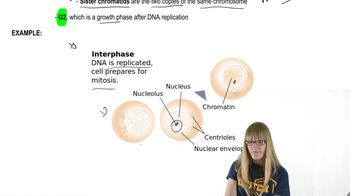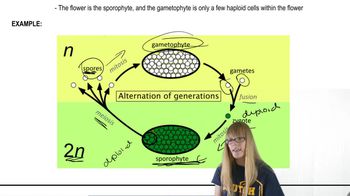Describe the organization of the interphase nucleus. Include in your presentation a description of chromosome territories, interchromatin compartments, and transcription factories.
Table of contents
- 1. Introduction to Genetics51m
- 2. Mendel's Laws of Inheritance3h 37m
- 3. Extensions to Mendelian Inheritance2h 41m
- 4. Genetic Mapping and Linkage2h 28m
- 5. Genetics of Bacteria and Viruses1h 21m
- 6. Chromosomal Variation1h 48m
- 7. DNA and Chromosome Structure56m
- 8. DNA Replication1h 10m
- 9. Mitosis and Meiosis1h 34m
- 10. Transcription1h 0m
- 11. Translation58m
- 12. Gene Regulation in Prokaryotes1h 19m
- 13. Gene Regulation in Eukaryotes44m
- 14. Genetic Control of Development44m
- 15. Genomes and Genomics1h 50m
- 16. Transposable Elements47m
- 17. Mutation, Repair, and Recombination1h 6m
- 18. Molecular Genetic Tools19m
- 19. Cancer Genetics29m
- 20. Quantitative Genetics1h 26m
- 21. Population Genetics50m
- 22. Evolutionary Genetics29m
9. Mitosis and Meiosis
Mitosis
Problem 8
Textbook Question
Contrast telophase in plant and animal mitosis.
 Verified step by step guidance
Verified step by step guidance1
Begin by defining telophase as the final stage of mitosis where the chromosomes arrive at opposite poles of the cell and begin to decondense, and the nuclear envelope re-forms around each set of chromosomes.
Explain that in animal cells during telophase, the cell membrane starts to pinch inward through a process called cleavage furrow formation, which eventually leads to cytokinesis (division of the cytoplasm).
Describe that in plant cells, because of the rigid cell wall, telophase involves the formation of a cell plate at the center of the cell, which will develop into a new cell wall separating the two daughter cells.
Highlight that the nuclear envelope re-forms in both plant and animal cells during telophase, but the mechanism of cytoplasmic division differs due to structural differences (cell wall in plants vs. flexible membrane in animals).
Summarize the contrast by emphasizing that animal cells use cleavage furrow for cytokinesis, while plant cells form a cell plate, reflecting adaptations to their cellular structures.
 Verified video answer for a similar problem:
Verified video answer for a similar problem:This video solution was recommended by our tutors as helpful for the problem above
Video duration:
3mPlay a video:
Was this helpful?
Key Concepts
Here are the essential concepts you must grasp in order to answer the question correctly.
Telophase in Mitosis
Telophase is the final stage of mitosis where chromosomes decondense, nuclear envelopes re-form around each set of chromosomes, and the cell prepares to divide. It marks the near completion of nuclear division before cytokinesis separates the cytoplasm.
Recommended video:
Guided course

Mitosis Steps
Cytokinesis Differences in Plant and Animal Cells
Cytokinesis follows telophase and differs between plants and animals. Animal cells form a cleavage furrow by constricting the plasma membrane, while plant cells build a cell plate from vesicles to create a new cell wall, due to their rigid cell walls.
Recommended video:
Guided course

Formation of Plant Gametes
Cell Structure Impact on Mitosis
The presence of a rigid cell wall in plants influences how cell division occurs, necessitating the formation of a cell plate during cytokinesis. In contrast, animal cells lack a cell wall, allowing the membrane to pinch inward easily during division.
Recommended video:
Guided course

Mitosis Steps
Related Videos
Related Practice
Textbook Question
681
views


